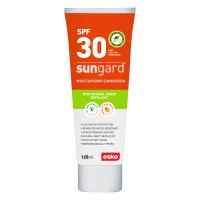SKIN PROTECTION
What’s The Risk?
As we all know, intensity of UV radiation in New Zealand is very high, especially in summer.
Our melanoma incidence is the highest in the world and skin cancer is by far New Zealand’s most common cancer.
There are about 82,000 new cases of skin cancers each year, compared to a total of 16 000 for all other types of cancer. The incidence of melanoma in NZ is higher than Australia and around twice as high as Canada, the US or the UK.
If you are an employer and your staff are working outside, especially during summer months, you need an appropriate UV safety program, which includes supplying staff with an effective sunscreen. WorkSafe’s guide Protecting workers from solar UV radiation recommends sunscreen that is broad-spectrum (protects from UVA and UVB radiation), with a protection factor (SPF) of 50+, compliant with AS/NZS 2604, and water resistant.
What Is SPF?
Our melanoma incidence is the highest in the world and skin cancer is by far New Zealand’s most common cancer.
There are about 82,000 new cases of skin cancers each year, compared to a total of 16 000 for all other types of cancer. The incidence of melanoma in NZ is higher than Australia and around twice as high as Canada, the US or the UK.
If you are an employer and your staff are working outside, especially during summer months, you need an appropriate UV safety program, which includes supplying staff with an effective sunscreen. WorkSafe’s guide Protecting workers from solar UV radiation recommends sunscreen that is broad-spectrum (protects from UVA and UVB radiation), with a protection factor (SPF) of 50+, compliant with AS/NZS 2604, and water resistant.
What Is SPF?
The SPF (Sun Protection Factor) number is calculated by simulating in-the-field conditions in a laboratory. This involves exposing the skin of volunteers to various amounts of simulated sunlight before and after the application of a standard amount of sunscreen. The SPF of a sunscreen is derived by taking the time it takes the trial participant to burn with a sunscreen and dividing it by the time taken for the participant to burn without a sunscreen. For example, if the trial participant burns in 300 minutes with a sunscreen and in 10 minutes without a sunscreen, this is calculated as 300/10 = 30; an SPF of 30. Esko SunGard SPF50+is laboratory tested in Australia to validate its SPF50+ rating and effectiveness against UVA/UVB radiation.
Using Sunscreen Effectively
Using Sunscreen Effectively
• Use a sunscreen with an SPF of at least 30 on all exposed skin.
• You may need a higher SPF if you are fair-skinned, if you will be in the sun for a long time, or if UV exposure is intense (eg, at the beach or skiing).
• Use a broad-spectrum sunscreen like Esko SunGard that protects against both UVA and UVB radiation.
• Apply sunscreen generously to all exposed skin 15 to 30 minutes before exposure and remember to apply to your ears. Approximately two tablespoons of sunscreen (about a shot glass full) is needed to cover an adult’s arms, legs, neck, and face.
• Reapply sunscreen after sweating, rubbing the skin, swimming or drying off with a towel. Reapply every two to three hours.
• Additionally, protect your lips with lip balm.
Sunscreens Need to be Applied Liberally to Achieve the SPF Protection Claimed on the Label.
• You may need a higher SPF if you are fair-skinned, if you will be in the sun for a long time, or if UV exposure is intense (eg, at the beach or skiing).
• Use a broad-spectrum sunscreen like Esko SunGard that protects against both UVA and UVB radiation.
• Apply sunscreen generously to all exposed skin 15 to 30 minutes before exposure and remember to apply to your ears. Approximately two tablespoons of sunscreen (about a shot glass full) is needed to cover an adult’s arms, legs, neck, and face.
• Reapply sunscreen after sweating, rubbing the skin, swimming or drying off with a towel. Reapply every two to three hours.
• Additionally, protect your lips with lip balm.
Sunscreens Need to be Applied Liberally to Achieve the SPF Protection Claimed on the Label.






